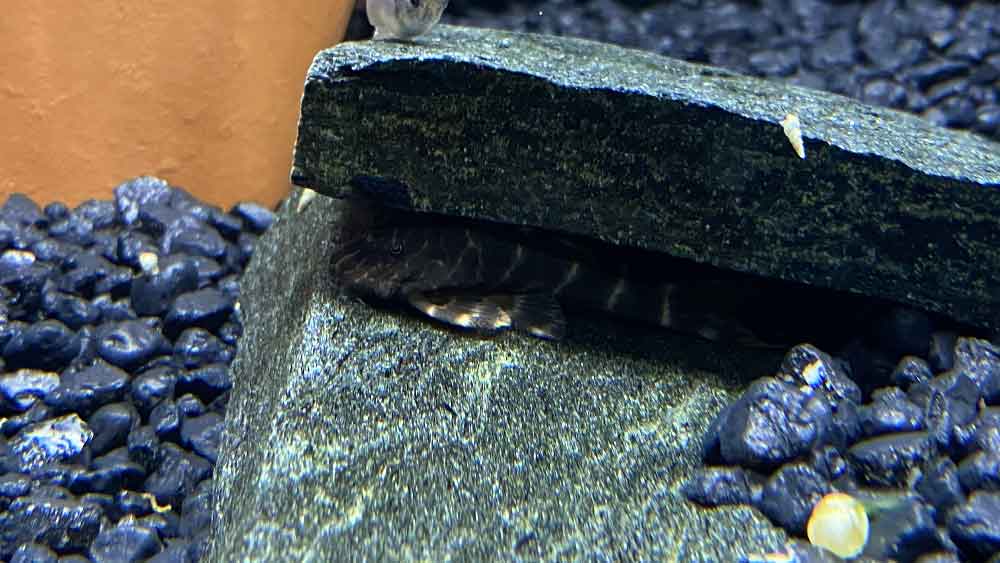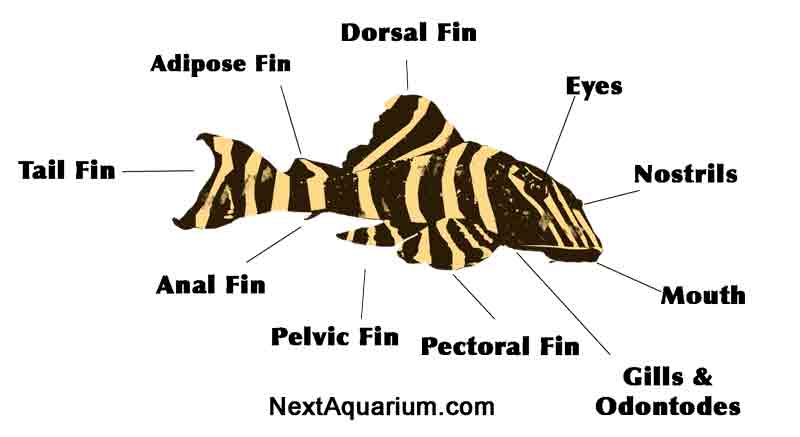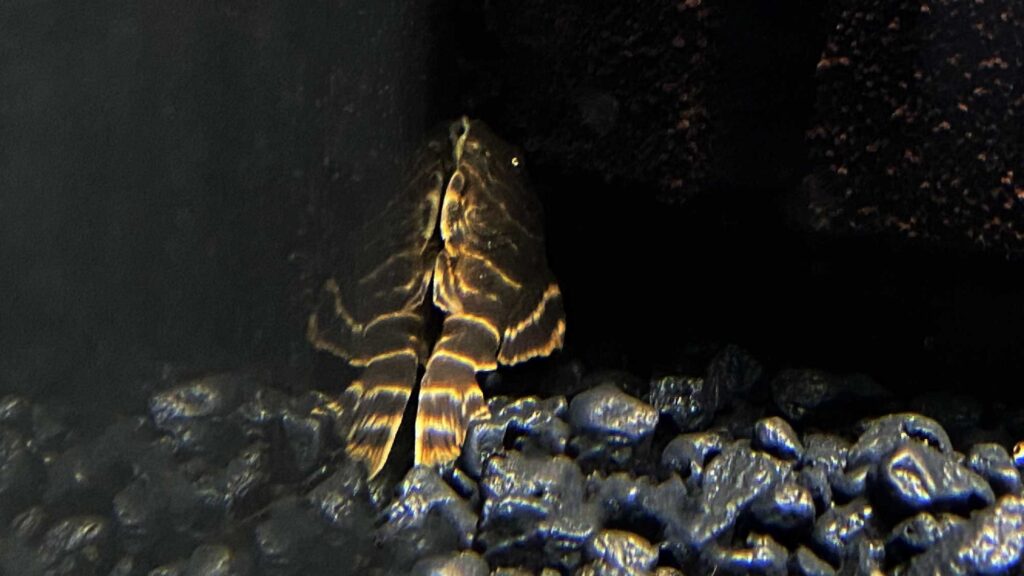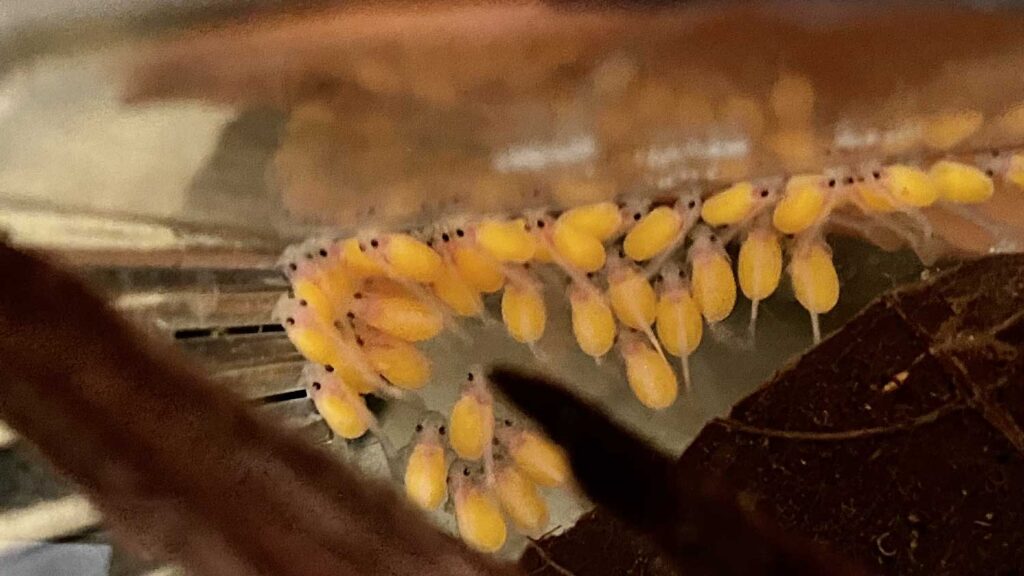Clown Pleco (Panaqolus maccus) has become one of the most popular plecos among aquarium owners. Their unique appearance and ease of care is the reason this fish was able to make it to aquarists’ hearts. This is a unique-looking pleco fish that will bring beauty and functionality to your aquarium.
In this care guide, we will cover all the basics of clown pleco care and everything else you need to know about this fish. If you want to bring this fish home, you’ve come to the right place!
Overview
Clown pleco is an armored catfish from the Loricariidae family (plecos) native to the Amazon River in South America. Venezuela and Columbia are where this fish is being collected for the aquarium trade. In pet stores, you might see this fish under different names like Clown Pleco, Clown Panaque, L104, or L162. All these are different representations of the same fish.
In the wild, this fish lives in rivers and streams filled with driftwood and fallen trees that make up a big portion of this fish’s diet. They use these fallen wood to hide, eat, and breed. Clown Plecos are wood eaters and will forge in the water for a perfect hiding spot that will also provide them with enough wood to eat as well as other vegetables and insects to feed on.
Same as in nature, you will need to provide them with driftwood, hiding spots, and a diet of vegetables and crustaceans to make sure they live a healthy life in your aquarium. This fish is a bottom dweller and will need a bigger aquarium with a bigger bottom area.
Their behavior is something that any aquarist can appreciate. Not only are they fun to watch move around the bottom and nibble on driftwood, but they get along well with a lot of other species. They are very peaceful fish and will not harm other fish or invertebrates.
Appearance

This dwarf pleco has different-colored markings which help them stand out in a tank. No matter what type of fish they share a tank with, they will still grab your attention. This fish is mostly covered in a dark color, with bright orange stripes across the body. The bright orange stripes might be dark orange or washed whitish-yellow. The vibrancy, pattern, and color of their body can be slightly different from fish to fish.
They are more colorful and vibrant when they are young and as they grow and mature they will slowly lose their colors and patterns might slightly fade. This is more common with wild-caught specimens. However, in captivity, they seem to hold on to their colors and patterns even when they are mature.
This fish, like all Plecos, has an armored back that feels boney when touched. Their belly is very soft and fragile, this is why they rarely swim in the water column to avoid exposing their soft spots to predatory fish.

The shape of the body is similar to all pleco catfish in the Loricariidae family. They have a big and plumped head and body with a long cylinder tail. They have a large dorsal fin, 2 pectoral fins, 2 pelvic fins, a tail fin, an anal fin, and an adipose fin.
The Clown Pleco has a tall dorsal fin compared to its body that stands high on its back. They also have large pectoral fins and often rest behind them while laying on the bottom.
Lifespan
Under the right conditions, Clown Pleco’s lifespan is about 10-12 years. This means you will have to commit to these fish for a long time. When water parameters and diet are not in their favor they will have a shorter lifespan. A bad diet, low water quality, and stress will reduce the life expectancy of this beautiful fish.
Clown Pleco Size:
One of the many dwarf pleco species, the clown pleco grows to only 3.5 – 4 inches (8.75 – 10 cm) in size. This makes them a good fit for most tank sizes and you will not have to worry about them out-grow your tank.
Behavior & Temperament
Clown Plecos are beautiful, interactive, and peaceful fish. They don’t mind living with other types of fish and will not harm other species this makes them a perfect fish for a community tank. They prefer to swim at the bottom of the tank without causing any trouble for other fish.
However, these fish are territorial and will fight with other bottom dweller fish over their favorite spot. This is more common among males and will often fight over caves and hiding spots. When two or more clown plecos are placed in the same tank, the dominant male will take the best cave and the rest of the males might try to take the cave from him. They might fight to the death over the cave or the hiding spot.
To solve the aggression between the males, simply add more caves and place them in different parts of the tanks so the males don’t get into each other’s way. Females don’t show as much interest in the caves as males do. When it comes to caves and hiding spots, the more the better.
L104 Clown Pleco Care:
This easy-to-care fish prefers to live in well-aerated warm water with enough water flow. The best way to care for Clown Pleco is to try to make your aquarium as close to nature as possible. To make this happen, you should place lots of driftwood and rocks in your aquarium. They also like to have lots of plants in the fish tank.
Overall, this fish is easy to care for and can tolerate a wide range of water parameters.
Tank Size:
The minimum tank size for Clown Pleco fish is 20 gallons for small fish like this one. This is a dwarf pleco and does not need a very big aquarium. However, in order to house a group of these fish, you will need to provide them with a bigger space.
We recommend having at least a few of them in your tank as they tend to hide a lot. Having a single Pleco in a large tank means you might rarely see your pleco. This is a relatively affordable fish, which means you can easily get your hands on a group of them.
Tank Setup:

You’ll find your Clown Plecos thrive when you mimic its natural environment where it gets a lot of different types of driftwood, rocks, and sandy substrate.
Driftwood is a part of this fish diet so it’s a must-have in your rank. Rockets will provide hiding spots for the fish and make them feel safe and reduce their stress levels.
These fish are sitting on their bell almost all the time and they have a very soft belly. This means you will need to provide them a soft sandy substrate so they do not accidentally harm themselves.
Plecos are nocturnal fish meaning they are mostly active during the night when other fish are resting. This means during the day they will need somewhere to hide from other predator fish both in the tank and in the aquarium. You will need to make sure they will have many hiding spots available for them.
You should provide them with as much natural decoration as possible. Placing a few caves can also be beneficial in lowering stress levels. Adding pleco caves is a great way to provide your fish with safe hiding spots.
Despite being herbivores in nature, clown pleco will not cause any harm to living plants. If you see they are mulching on your plant, they are either eating algae off the plant or the leaf is dying.
Lighting:
Clown Plecos do not have specific lighting needs and can adapt to any lighting conditions in the aquarium. So it’s best to choose your light based on the plants you are keeping in the tank.
In general, bottom-feeder fish do better in shades which means you should avoid very strong lighting if you don’t have plants. If you have live plants, then try to add more decorations and hiding spots for them to hide during the time aquarium lights are on.
LED lights are the best lighting available for aquariums. They are cost-effective in the long run and will provide your plants with the necessary light spectrum. Most LED lights come with an automatic timer and can be programmed to turn on and off at specific hours.
Filtration:
Clown Pleco eats a lot, which leads to high levels of waste in your tank. You will need a filtration system that can handle the waste produced by plecos.
If the filtration of your tank can not keep up with the waste products in the aquarium, it will affect the health of the fish. Your fish might get internal or external infections or diseases, or even face death.
To solve this problem, we need to have a good filtration system that can filter the tank mechanically and biologically.
A hang-on back filter or canister filter is the best option for filtering the water. When purchasing a filter, always get one that can handle twice the gallons in your aquarium. The bigger the filter, the better the environment for the fish. Bigger filters will also provide more water movement, which plecos love.
Water Parameters:
Clown Pleco L104 loves well-aerated warm water with a moderate water current in the tank. You can add an air stone or a powerhead to improve the water flow in your tank while aerating your aquarium at the same time.
Maintaining constant parameters in your tank is the key to the health of this fish. You should always avoid fluctuating water parameters in your tank. The following is the range this fish can handle.
- Water temperature: 73°F – 82°F
- pH levels: 6.8 to 7.6
- Water hardness: 10 GH
Clown pleco Diseases & prevention:
Plecos in general are hardy fish and do not get sick very often. When water parameters are not optimal or fish are under stress they tend to get sick. They are also susceptible to all common aquarium diseases that other fish might carry.
Prevention is the best cure! Remind yourself to clean the tank regularly and keep an eye on the water parameters. Do regular water changes and provide them with good food. Avoid adding any new fish to your tank without properly quarantining it.
Diet and Feeding Requirements
Clown Pleco is a wood-eating fish and you should decorate your tank with many different types of driftwood. While wood is the main part of clown pleco’s diet, they will also eat other vegetables, crustaceans, and insect larvae. Zucchini, cucumber, and other vegetables should be the main types of fresh food they get.
Algae is also one of the main food sources they have in the wild. You can easily supplement this by feeding them algae wafers. Fresh vegetable and algae wafers should be the main food source they get with occasional meaty frozen food.
You can also try to grow natural algae in your tank by increasing the light duration in your tank. Just make sure you find the right balance, you don’t want to have more algae in your tank than what your fish can consume.
For optimum health, supplement frozen food like bloodworm and brine shrimp two or three times per week. The key to remember is to give them a good mix of different foods so they get all the nutrition they need.

Gender Differences
Males and females will look very similar and almost impossible to distinguish them at a young age. When fish get mature the males will start to develop odontodes on their pectoral fins and on the dorsum (back of the body). These odontodes are more visible during the breeding season.
Compared to males, females have much wider bodies when viewed from above. Males develop pointed genital papillae and mature females will have rounded papillae.
breeding and reproduction:

Breeding plecos is a delicate and sometimes frustrating process. Breeding Clown plecos can be done in aquariums when the conditions are right.
In order to breed these fish, you will need your Clown plecos to be mature and at least 2-3 years old. Once you confirm you have at least one male and one female in your breeding group, you can start to condition your fish for breeding.
If you have more males in your tank, then make sure that each male has a cave available in the tank for them. The rule of thumb is to add one cave per male if not more. It’s best to have a separate breeding tank for the group where no other fish is present.
Clown Plecos are cave breeders which means they need caves to breed. The cave should be slightly bigger than the male’s body; but, small enough that he can trap the female inside.
For breeding purposes, the male looks around for a suitable cave to trap the female in. When the male finds a suitable cave, he will clean it out and wait for the female to arrive. The male will then trap the female and will not let her leave the cave until she lays eggs.
Once eggs are laid, the male will let the female leave the cave, and then he will fertilize the eggs. It’s the male job to guard the eggs until they hatch. During this time, the male cleans the eggs and fans them so the eggs don’t go bad or get mold.
The eggs usually hatch 7-10 days after being laid.
After hatching, the fry usually stays at the back of the cave and feeds on their egg sacks for the next few days. The male will keep the fry in the cave for another 5-7 days until they are fully developed and ready to leave.
Once the fry are strong enough, they will escape the cave and will attach to driftwood or glass in the aquarium. The fry usually stays together in a cluster in a single spot until they grow to an inch in length.
Clown Pleco Tank Mates
Clown Plecos are very peaceful fish and will not harm other fish and plants. They can live with any peaceful to medium-aggressive fish. They are a great community fish!
However, we do not recommend keeping this pleco with super aggressive fish as they might eat your Pleco or stress it out to death. In a big aquarium, this fish can live with any cichlid that has a small mouth such as angelfish or discus.
Ideal Tankmates for Clown Pleco
Some of the fish plecos are most compatible with clown plecos:
- Rasboras
- Dwarf gourami
- Neon tetras
- Betta Fish
- Livebearers
- Angelfish
- Mystery snails
- Zebra Danios
- Bala shark
- Jewel cichlid
- Other Plecos
Suitable Plants:
Clown pleco loves plants. Adding live plants will reduce the stress levels in the fish while having many different benefits to the tank. The following are a few plants you might consider adding to your tank:
Are Clown Plecos Right for You?
If you have never owned a pleco before and are planning to get one, we highly recommend the Clown Pleco. They stay small and will not outgrow your tank.
If you have a 20-gallon or up aquarium that can house an extra pleco then this is the fish for you.
Conclusion
Clown pleco is a dwarf pleco that looks beautiful and will not outgrow your tank. Keeping this pleco is easy and will not require a lot of maintenance. With a clean well-maintained tank these fish can live and entertain you for a long time.
If you have any questions or need more help please reach out to us on social media or via our contact us page. We would love to help.